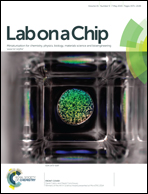Research highlights: translating chips
Abstract
Microfluidic and microfabricated systems are providing key functionalities in diagnostic and therapeutic scenarios, translating beyond the research laboratory to pre-clinical animal studies and clinical studies with patients. Here, we highlight a recent study making use of miniaturization and automation in the development of a smartphone-integrated point-of-care diagnostic to detect antibodies to infectious diseases in a global health setting. We also review an intraocular implanted diagnostic system for glaucoma that relies on imaging the location of a fluid meniscus in a microchannel to readout pressure within the eye. Developments in low-cost and highly functional consumer electronic systems (e.g. smartphones in both highlighted works) has led to a continuing trend to incorporate such technologies with microfluidic fluid handling capabilities to achieve complete diagnostic solutions. We conclude with another implanted microdevice that delivers drug locally to tumors through electroosmotic flow and electromigration of charged drug species, which allows high drug concentrations near a tumor or resected tumor site while preventing high systemic levels associated with significant side-effects. The maturity of microsystem components are now allowing integration into fully functional systems that are poised to reach the clinic in a variety of forms – diagnostic to therapeutic.


 Please wait while we load your content...
Please wait while we load your content...